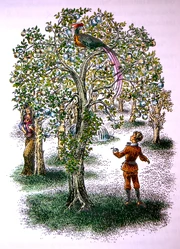
The Garden of Youth (or simply, the Garden) was an isolated orchard that was believed to be located near the Western March of Narnia, in the Western Wild, on the crest of a green hill, and was the Great River's source.
Description
The Garden was enclosed by high walls of green turf, which was broken by a single pair of high solid, golden gates that faced due east.
On the gates, in letters of silver, were written the words: -
- Come in by the gold gates or not at all,
- Take of my fruit for others or forbear,
- For those who steal or those who climb my wall
- Shall find their heart's desire and find despair.
The Garden was a beautiful and happy place, where the leaves of the trees "showed not only green but also blue and silver when the wind stirred them", and there was also a most lovely smell all about, one that was "warm and golden, as if from all the most delicious fruits and flowers of the world". However, it was also a place of intense privacy, to the extent where one "could see at a glance that it belonged to someone else. Only a fool would dream of going in unless he had been sent there on very special business". One other notable feature about the Garden would be its solemn silence - though the gates would swing open of their own accord when one placed his hand on them, they did so without the least noise, and "even the fountain which rose near the middle of the garden made only the faintest sound".
In the centre of the Garden stood an enormous silver apple tree, the Tree of Youth, in whose branches roosted a lone phoenix, the apparent Guardian of the Garden.
History
Since the Garden was only ever known to be explored in Narnian-Year 1, and was otherwise absent throughout the rest of Narnia's history, much about it still remains a mystery. However, it still played a particularly important role in Narnian history, due to the unique magical properties of its silver apples: as warned by the words on the gates, people were not supposed to pluck and eat the apples of their own accord, but were encouraged to pluck and use them to help others in need.
The only two people known to ever visit the Garden were Digory Kirke from Earth, and Jadis from Charn. Each plucked an apple from the Tree of Youth; Jadis took the fruit and ate it for personal gain, while Digory, on the other hand, took it only at the request of Aslan.
By doing so, Digory was forced to face two devastating temptations: First, he very much wanted to eat it himself the instant he smelt it ("A terrible thirst and hunger came over him and a longing to taste that fruit"), and he learned from Jadis that the apple would grant him eternal life as well as endless youth if he ate it. The second temptation, as also revealed by Jadis to him, was that he could use the fruit to save his gravely ill mother's life.
Very fortunately, Digory was able to resist both temptations, and by doing so he saved both himself and his mother from terrible fates that would have taken place if he had succumbed to either one of the temptations, given that the fruit will not work happily for those who pluck it at their own will.
Jadis, on the other hand, had actually doomed herself: The fruit she ate did indeed grant her her heart's desire of being immortal and having inexhaustible strength, but it also brought her despair, given that she would always be miserable and never happy. And because she was immortal, that meant that her constant misery would never end.
The apple that Digory plucked was later planted near the river bank, where the ground was soft, and it grew into a magnificent adult tree in only a matter of minutes. Aslan stated that this tree would prevent the return of Jadis as long as it flourished, later named the Tree of Protection.
A week or so after Narnia's creation, the Garden of Youth presumably vanished into Aslan's Country.
This was also where the true story of the real Narnia had begun.